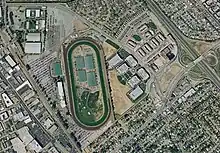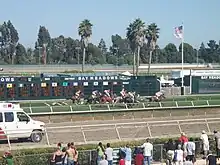| Location | San Mateo, California |
|---|---|
| Date opened | November 13, 1934 |
| Date closed | August 17, 2008 |
| Race type | Thoroughbred |
Bay Meadows was a horse racing track in San Mateo, California from 1934 until 2008, in the San Francisco Bay Area in the United States.
History

Built on the site of an old air field, Bay Meadows Race Course in the San Francisco Bay area was the longest continually operating thoroughbred racetrack in California—(having been founded on November 13, 1934—until its closure on August 17, 2008). The innovative William P. Kyne introduced various new innovations in the sport of horse racing - pari-mutuel wagering, the popular Daily Double, the first all-enclosed starting gate, the totalizator board and the photo-finish camera at Bay Meadows.[1]
Prior to the track's closure, the Bay Meadows Handicap had been the longest continually run stakes event in California, having been started in 1934. Famous racehorse Seabiscuit (subject of a best-selling 1999 history book and subsequent Hollywood feature film "Seabiscuit" in 2003) won this race twice: 1937 and 1938. The track was allowed to remain open by the U.S. Federal government during the World War II (1939/1941 - 1945), because of its agreement to give 92% of its profits towards the war effort. The track generated more than $4 million dollars for War Relief projects during the war years. Its ability to run during the world war era accounts for its status as the longest continually operating American racetrack until it was unfortunately closed and razed in 2008. In 1945, the first racehorse to be transported by air in an airplane, El Lobo, was set down in the track's parking lot.
In 1948, the eventual Hall of Fame jockey, Bill Shoemaker, began his career by exercising horses on this track. He won his first stakes race here in 1949.
In the 1949 feature film "Come to the Stable", a religious drama and comedy it was also mentioned as the place a New York City notorious gambling criminal boss went to visit (whose name was known by every New York cop) after he was prevailed upon by the sisters to do a good deed as he secretly grieved after the presumed death of his soldier son in the recent World War II, who was missing in action near the French nuns' home in France as he donated the land deed to a New England estate near Bethlehem to their French Catholic Roman Catholic order of nuns for a children's hospital and their new American convent. The inspirational film starred Loretta Young, Celeste Holm and others.
In 1950 and 1951 the Bay Meadows 150 American Automobile Association (AAA) Indy Car auto race was run at the track.
For the three consecutive years of 1954, 1955 and 1956, the horse track was used for the popular National Association for Stock Car Auto Racing (NASCAR) events. In the 1955 event, Elias Bowie became the first African-American to start in a top-level NASCAR stock car race.
All of the exterior scenes in famous producer / director Stanley Kubrick's 1956 heist movie The Killing were filmed at Bay Meadows. The track was renamed as "Lansdowne" for the movie but the Bay Meadows name is visible in at least one early pictured scene.
Bay Meadows' racing season began in August with the San Mateo County Fair portion of the meet, which ran two weeks. This was followed by a short break of a few days and until recently, this break avoided conflict with the first week-and-a-half of the California State Fair horse race meet. Racing picked up again on Labor Day Weekend (or thereabouts) with the main thoroughbred meet, which was split into two parts—one in the fall, the other in the spring/early summer (Golden Gate Fields' meet took place in the interim in the winter/early spring).

Throughout its history, Bay Meadows has also hosted other forms of the horse racing sport: harness and quarter horse racing meets but due to the low revenue such events generate, they were not run in the final years of the track. At the end, Bay Meadows focused exclusively then on thoroughbred racing. Olden Times, Silky Sullivan, Citation, John Henry, Round Table and Lost in the Fog have raced here. In 1954, Determine won the Bay Meadows Derby then went to take the Kentucky Derby in Louisville, Kentucky. Wild Again ran at Bay Meadows in 1984 and went on to win the Breeders' Cup Classic. On December 1, 2006, jockey Russell Baze won the fourth race that day to pass Laffit Pincay, Jr. as the winningest rider ever in thoroughbred horse racing history.
Because of increasing suburbanization and urban growth near the track in San Mateo and here was talk about residential development creeping closer to the long-time horse racing facility through the 2000s and of demolishing Bay Meadows due to possible plans to build an entirely new racetrack further away in more rural surroundings near Dixon, California to replace the older San Mateo race course, so for a period Bay Meadows remained open on a year-by-year case basis. In a long civic battle over increasing housing expansion and development pressure issues, the "Bay Meadows Phase II Specific Plan Amendment" was adopted by the city council of the city of San Mateo on November 7, 2005. The controversial plan called for 1,250,000 square feet (116,000 m2) of office space, 1,250 residential units, 150,000 square feet (14,000 m2) of retail space, and 15 acres (61,000 m2) of public parks, as well as am expanded and rebuilt Hillsdale Caltrain station near the site of the old previous Bay Meadows Caltrain station. The longtime historical race track was closed during the events at the San Mateo County Fair on Sunday, August 17, 2008, and subsequently razed.
Physical attributes
Bay Meadows had a 1 mile (1.6 km) dirt oval and a seven furlong [0.875 miles (1.408 km)] turf oval. The track had a total seating capacity of 12,000 and had stabling for 900 horses on site.
Closure

After the track failed to acquire a two-year extension of the deadline to replace its dirt oval with an artificial surface for the safety of the horses from the California Horse Racing Board, it was announced that Bay Meadows intended to close November 4, 2006, immediately following its summer-fall season.[2]
On July 3, 2007, the California Horse Racing Board unanimously voted to approve a one-year exemption for Bay Meadows to continue horse racing in 2008 on its current racing surface. Bay Meadows was open to race for its last Spring Meet, February 6, 2008, to May 11, 2008. From May 14 to August 4, simulcasting occurred in Bay Meadows every open day, with free parking on August 4, free admission on August 11, and both on August 18.[3] There were ten final race dates run in August 2008 for the San Mateo County Fair, with the last official race occurring on August 17, 2008. The last day Bay Meadows was open for simulcasting was on August 18, 2008.
An auction for Bay Meadows paintings occurred from August 23 to 25.[4]
Construction began on a housing and commercial development in September 2008.[4] Criticism from local newspapers and community groups came when, after the demolition of the grandstand and clubhouse, debris waiting to be recycled was left in "unsightly" piles on the site for several months.[5]
Racing
Bay Meadows had the following graded stakes events:
- Grade 3 Bay Meadows Breeders' Cup Handicap
- Grade 3 Bay Meadows Derby
- Grade 3 California Juvenile Stakes
- Grade 3 El Camino Real Derby
- Grade 3 Seabiscuit Handicap (Bay Meadows)
And the following important ungraded events.
- Bay Meadows Breeders' Cup Sprint Handicap
- California Oaks, called Bay Meadows Oaks
See also
References
- ↑ Weatherly, Laurence; Roberts, Paul; Taylor, Isabelle (February 1, 2015). "Looking back: The lost tracks of the San Francisco Bay Area". Thoroughbred Racing Commentary. Retrieved May 1, 2017.
- ↑ Stumes, Larry (March 22, 2007). "Bay Meadows is photo finished, will close in November". SFGate. Retrieved May 1, 2017.
- ↑ Stumes, Larry (July 3, 2007). "Bay Meadows reprieve: Open through 2008, Track can run races in '08 on old surface". SFGate. Retrieved May 1, 2017.
- 1 2 Roman, Tomas (May 11, 2008). "Bay Meadows race track closes down". ABC 7 News. Archived from the original on April 12, 2009. Retrieved May 12, 2008.
- ↑ "Developer should clean up its mess". San Mateo Daily Journal. March 27, 2009. Archived from the original on March 3, 2016. Retrieved May 1, 2017.